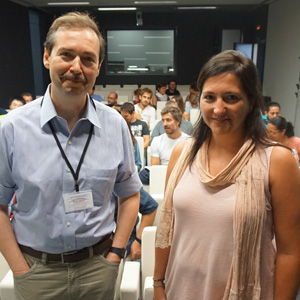The talk held on September 4th, 2015, was entitled “Electromechanical Behavior and Electronic Properties of Complex Oxide Heterostructures and Hybrid 2D Ferroelectric Devices”. Prof. Alexei Gruverman, from the University of Nebraska-Lincoln, has played a key role in the field of ferroelectric and multiferroic oxides. Dr. Neus Domingo introduced the Seminar.

Over the last several years the field of ferroelectric and multiferroic oxides has been experiencing a significant revival. This is largely due to recent experimental advances allowing characterization of their functional properties down to the nano- and atomic scale. Specifically, Piezoresponse Force Microscopy (PFM) proved to be an indispensable tool for high-resolution characterization of ferroelectrics (FE), and more recently has been shown to play a critical role in the study of electromechanical properties of FE-based electronic devices.
On September 4, 2015, Prof Alexei Gruverman, from the Department of Physics and Astronomy, University of Nebraska-Lincoln, offered an ICN2 Seminar entitled “Electromechanical Behavior and Electronic Properties of Complex Oxide Heterostructures and Hybrid 2D Ferroelectric Devices”. Dr Neus Domingo, from the ICN2 Oxide Nanoelectronics Group, introduced the speaker and his lecture.
This lecture focused on application of the advanced PFM modes to investigation of the dynamic switching and electronic properties of ultrathin (in the range of several unit cells) complex oxide heterostructures. This included critical polarization behavior in single-crystalline ferroelectric films, polarization-driven electroresistance effect in ferroelectric tunnel junctions and switchable hysteretic electromechanical behavior of the LaAlO3/SrTiO3 (LAO-STO) heterostructures.
He also discussed implementation of the hybrid electronic devices comprising 2D materials and FE thin films (2D-FE) that exhibit polarization-controlled non-volatile modulation of the electronic transport. While many 2D materials can be considered in conjunction with FE materials, the speaker primarily focused on the use of graphene and transition metal dichalcogenide MoS2. Specifically, he showed how polarization reversal can modulate (1) the in-plane transport of the interfacial conducting channel in the FE field effect devices, and (2) the perpendicular-to-plane tunneling conductance in the FE tunnel junction devices.

